Media | Articles
6 Oddball Concept Cars from the 1990s
We love talking about concept cars of every era, but the 1990s have a special place in our heart. It was a good decade for automotive diversity, especially for enthusiasts: SUVs were emerging as a hot new segment, true, but none of them purported to be a coupe or track star. Sport sedans thrived. So did hot hatches. The Miata debuted in 1989, kicking off the roadster craze. Chrysler was, for most of that decade, just Chrysler—not some confusing multinational conglomerate with a name that no one remembers.
Even the automotive ideas that didn’t make production had pizzazz—in a few cases, as you’ll see below, perhaps a little too much pizzazz. We’ve covered ’90s concepts before, but after a spin through the treasure trove that is Alden Jewell’s catalog of car brochures on Flickr, we decided it was time to focus on the concept cars from the U. S. of A., rather than the European contingent that dominated that last list.
Step back in time with us to an era when Buick was thinking of wild sedans, Pontiac was still cool, Mercury … existed, and Dodge was high off the Viper.
1999 Buick Cielo
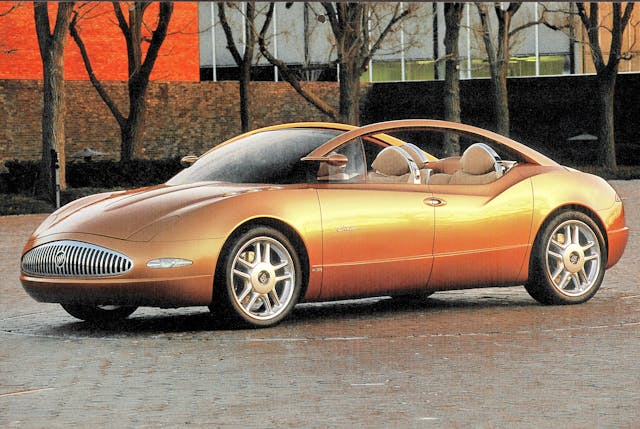
If you thought Buick’s newest concept car was unorthodox, prepare yourself: The Cielo is much, much more out-of-the-box. (Despite that throwback grille texture, which is very Y-Job.) A four-door convertible, with retractable headlights and voice-operated doors? You’d never know this thing was based on a highly modified Regal GS. The top, complete with its rear glass, stowed beneath a panel at the back thanks to a cable system hidden in the two arches that frame the “roof.” Power came from a supercharged 3.8-liter V-6 making 240 horsepower.
Judging by the much tamer concept of the same name that Buick showed off the following year—and marketed as a possible limited edition—the automaker thought the convertible four-door idea had legs. In Buick’s words, the Cielo “proves just how broad and flexible and contemporary the idea of a premium family car really is.” Little did Buick know that, 15 years later, the only premium family car the people would want was an SUV …
Marketplace
Buy and sell classics with confidence



1997 Mercury MC4
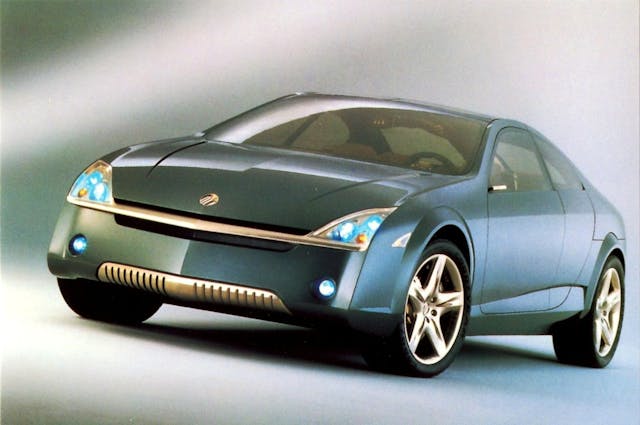
Motortrend got rather excited about the MC4 when it debuted in 1997: “The MC4 is for Mercury what the Viper Roadster was for Dodge nine years ago.” Yes, it was far more interesting to look at than the blob-like Mystique or the softly contoured Mountaineer … but no one knew that, 13 years later, Mercury would stop producing vehicles, its sales cannibalized by parent company Ford.
In 1997, however, Mercury’s star shone far brighter. The MC4 wore the edgy, minimalist look characteristic of Ford’s New Edge design language, initiated by the GT90 concept in 1990 and most familiar to folks on the 1999 Mustang. A trapezoidal grille and emphasized wheel arches are common to both that Mustang and the MC4, which actually started life as a V-8–powered ’96 Thunderbird. Unlike the T-Bird, the Mercury concept boasts four doors and a rear cargo area accessed by a pair of gullwing doors. It had style, space, and, of course, a healthy dose of tech that hadn’t quite been readied for production: video cameras instead of side- or rearview mirrors, nickel-chrome plate bedazzling the interior, and heated and cooled cupholders.
1997 Pontiac Rageous Concept
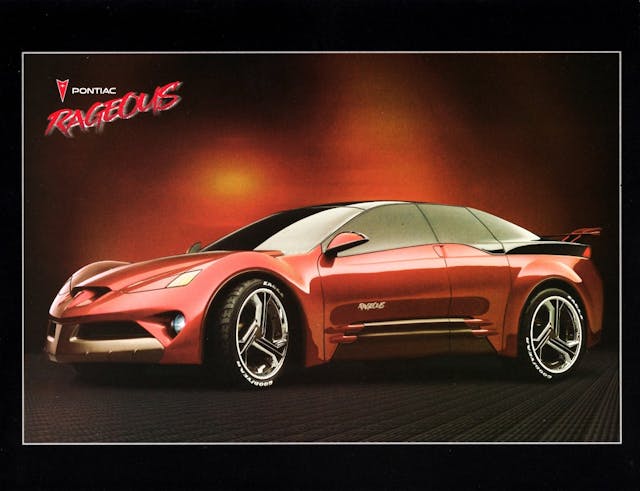
In 1997, Pontiac had four-door cars, and it had V-8–powered cars, but it didn’t have any V-8–powered, four-door cars. The Rageous, with its 350-cubic-inch small-block and vestigial set of rear doors, aimed to fix that. It could carry four people, but the trunk was accessed via a top-hinged hatch, making this more of a hatchback than a sedan. The Rageous had a six-speed manual transmission and a heavily vented, pointy schnoz that put that of the contemporary Firehawk to shame.

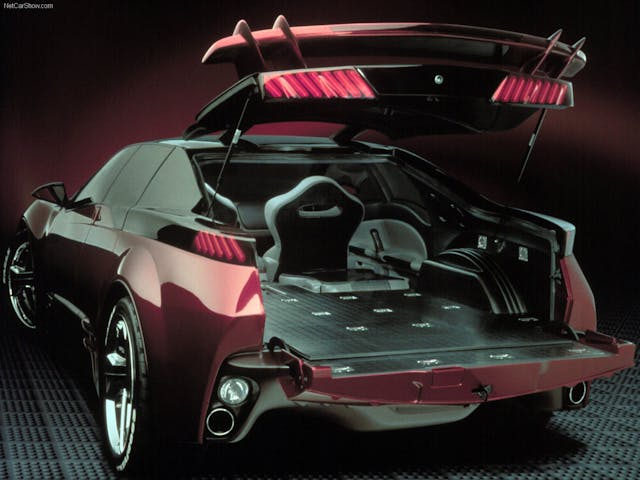
1994 Dodge Venom

If the Dodge Venom reminds you of a Neon, you’re on the right track: This 1994 concept was built on a version of the Neon’s platform. Unlike that compact, however, the Venom was rear-wheel drive. Compared to the sportiest Neon, the SRT-4, the Venom boasted an iron-block six-cylinder engine with 24, rather than 16, valves, and more power: 245 rather than 215 horses. The Venom looked like the perfect little brother to the Viper, which it honored with that side-scoop and squinty headlights atop a four-section grille. The concept even made the cover of Car and Driver‘s March 1994 issue, accompanied by the question: “Dodge’s pony car of the future?”
We wish such an affordable, spunky two-door had made production: Dodge wouldn’t have a direct competitor to the Mustang and the Camaro until the Challenger, which hit the streets 14 years later.
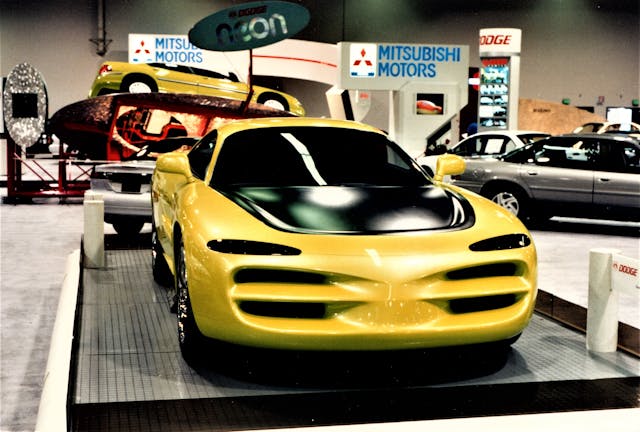
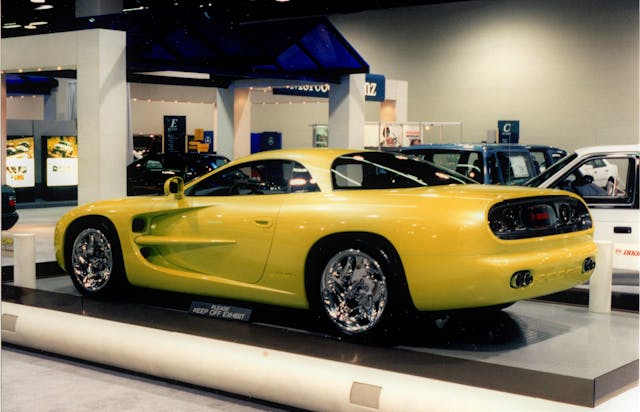
1995 Chevrolet El Camino SS Concept

It may remind GM fans of a Holden, but the El Camino SS Concept ute is a GM B-body at its core. GM’s Advanced Vehicle Development Center in North America built this ute out of a Caprice station wagon in just 16 weeks, grafting onto that people-hauler the nose of an Impala SS. Many of the steel body panels were made by hand. Power came from a 300-hp version of the LT1 V-8 found in the Corvette and the Impala SS (in different tunes) and was channeled to the rear wheels via a 4L60E Hydramatic transmission. Unfortunately, the platform that gave it birth spelled its doom: GM killed the age-old B-body at the end of 1996. RIP.
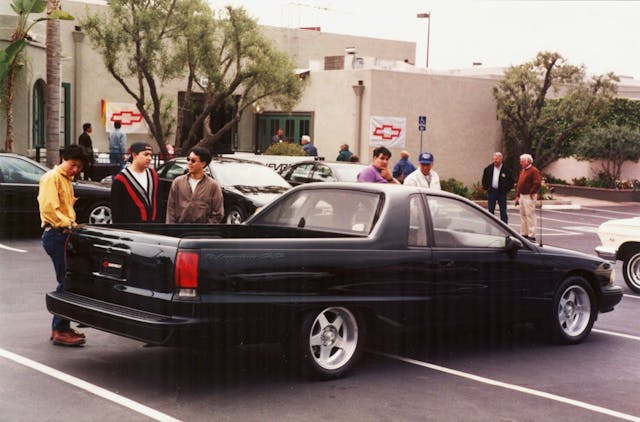
1994 Plymouth Expresso Concept

Would you believe us if we said this was a Plymouth? Maybe not, because the Expresso is more interesting than anything Plymouth made in the ’90s … until the Prowler arrived for the 1997 model year, at least. (That retro-mobile debuted in concept form the year before the urban runabout Expresso debuted.) The Expresso was built on the shortened frame of a Neon, to be sold under both the Dodge and Plymouth brands, and used the compact’s 2.0-liter four-cylinder to power its front wheels.
The four-door bubble would never reach production, but its name stuck around in the Plymouth lineup as a trim package on the Neon, the Voyager, and the Breeze. Be prepared to explain yourself if you mention this concept in front of a coffee snob: This weirdo’s name really is EX-presso, not Espresso. The proper pronunciation would be too … well, proper.
***
Check out the Hagerty Media homepage so you don’t miss a single story, or better yet, bookmark it. To get our best stories delivered right to your inbox, subscribe to our newsletters.


















The Buick would make a great car for Ronald McDonald. Paint those arches golden! I love the El Camino!
I remember the excitement the Venom generated. The article in Car and Driver was such a a tease as it highlighted the possibilities of building the Venom were easy using Neon parts and platform. I was ready to place a order. Then nothing but talk about the Prowler being the next Mopar boutique vehicle.
GM also killed the Oldsmobile which I thought was the next step down from a Cadillac
Seems like the Venom was based more on the Intrepid, externally speaking, than the Neon. With the right tools/skills one could get an old Intrepid equipped ES or RT package and modify it externally to emulate it, if the design is to your liking.
I like the El Camino coming back but it looks completely wrong on the mid 90’s Impala body. The 1997 Pontiac Rageous Concept is cool.
The car/pick-up makes sense to me. The four door, four foot bed, four wheel drive, four foot ground clearance, too big to fit in a garage, eighty thousand dollar pick-up never will.
Couple of years back someone had conversion kits to make a Chrysler/Dodge four door into a pick-up and at the time thought to myself that it would make a great use of the platform for Stale-lantis to sell more Hemi powered vehicles. HellCat and a half!
The Rageous is actually pretty sick.
Really, I mean really? There are comments here that purport to actually like these painted Easter eggs. With maybe the exception of the attempted El Camino resurrection these are the cars that began my disinterest in the automobile. Not to mention I stopped buying Car and Driver and Motortrend around this time. Car mag buying became purchasing just to be shocked (like reading the Daily Mail to see what the Beckhams and Kardashians are flogging this week) Don’t get me wrong, I am a born car junkie. I was one of those 4 year-olds that could name every car that approached ours on the street circa 1968 and onward but the industry accomplished what I thought was impossible. I had hoped the day would come when I would be like my dad and uncles who would stand around the driveway in the ’70s admiring someone’s new car. Today I wouldn’t even attempt to identify a car coming to pass me. I’m just not interested. Now that ’38 Chevy or the ’58 Chevy Fleetside I saw at the gas station yesterday….
I think the Venom & the Merc MC4 would have sold well. Not too space age but swoopy enough to get good comments at the gas station & car events
These cars look like Homer Simpson designed them, truly ugly at best.
Right on, Angie!!!
How about the Buick Avista. How about any stylish touring coupe instead of the same old same old, all look the same SUV. Heck Ford couldn’t even come up with a unique name for the Mustang SUV.
And all this time I was thinking that the Nissan Cube was the only Saturday morning TV comic car. Look like someone else was affected and conjured up the Ex-presso. At least it didn’t make it into production.
seen a few caprice and roadmaster wagons converted into ‘el caminos’ some done better than others – hadn’t seen the concept car back in the day but makes sense now why so many people tried their hand at doing it themselves
Did the El Camino SS live long enough to get tested for body flex?
THAT BUICK LOOKED LIKE THE 50’S NASH LOIS LANE AND CLARK(SUPERMAN) KENT RODE AROUND IN. SEDAN CONVERTIBLE, SOME CONCEPT. THEY DON’T DO ANYTHING LIKE THEY USED TOO. AT LEAST THE CONCEPT CARS OF THE 50’S & 60’S YOU COULD TAKE YOUR FAMILY WITH YOU. PONTIAC AND OLDS BOTH FELL OFF THE EDGE. THAT TRICK STARTED IN THE 70’S WHEN GM TRIED TO MAKE THE CARS ALL THE SAME TO SAVE MONEY. WHO WANTED AN OLDS WITH A 307 CHEVY ENGINE? I JUST CAN’T WAIT FOR THE FUTURE! HELLO SAMMY.